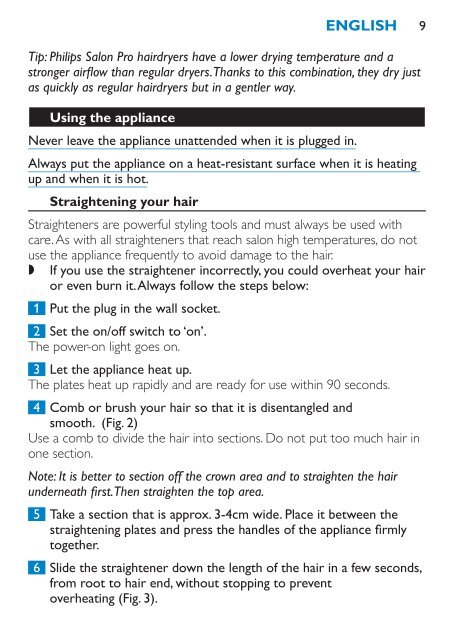Philips SalonStraight Essential Lisseur - Mode d’emploi - MSA
Philips SalonStraight Essential Lisseur - Mode d’emploi - MSA
Philips SalonStraight Essential Lisseur - Mode d’emploi - MSA
Create successful ePaper yourself
Turn your PDF publications into a flip-book with our unique Google optimized e-Paper software.
English<br />
<br />
Tip: <strong>Philips</strong> Salon Pro hairdryers have a lower drying temperature and a<br />
stronger airflow than regular dryers. Thanks to this combination, they dry just<br />
as quickly as regular hairdryers but in a gentler way.<br />
Using the appliance<br />
Never leave the appliance unattended when it is plugged in.<br />
Always put the appliance on a heat-resistant surface when it is heating<br />
up and when it is hot.<br />
Straightening your hair<br />
Straighteners are powerful styling tools and must always be used with<br />
care. As with all straighteners that reach salon high temperatures, do not<br />
use the appliance frequently to avoid damage to the hair.<br />
, If you use the straightener incorrectly, you could overheat your hair<br />
or even burn it. Always follow the steps below:<br />
1 Put the plug in the wall socket.<br />
2 Set the on/off switch to ‘on’.<br />
The power-on light goes on.<br />
3 Let the appliance heat up.<br />
The plates heat up rapidly and are ready for use within 90 seconds.<br />
4 Comb or brush your hair so that it is disentangled and<br />
smooth. (Fig. 2)<br />
Use a comb to divide the hair into sections. Do not put too much hair in<br />
one section.<br />
Note: It is better to section off the crown area and to straighten the hair<br />
underneath first. Then straighten the top area.<br />
5 Take a section that is approx. 3-4cm wide. Place it between the<br />
straightening plates and press the handles of the appliance firmly<br />
together.<br />
6 Slide the straightener down the length of the hair in a few seconds,<br />
from root to hair end, without stopping to prevent<br />
overheating (Fig. 3).
















